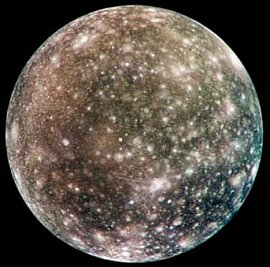The Strange Spires of Callisto
 When NASA's adventurous Galileo spacecraft skimmed a mere 138 km, (123 miles) above the surface of Jupiter's moon Callisto, onboard cameras captured the sharpest pictures ever of that moon's mysterious landscape. Scientists have since examined the images, and what they found is surprising. Callisto is peppered with strange icy features -- spires that seem to be slowly eroding on a world long considered changeless and dead.
When NASA's adventurous Galileo spacecraft skimmed a mere 138 km, (123 miles) above the surface of Jupiter's moon Callisto, onboard cameras captured the sharpest pictures ever of that moon's mysterious landscape. Scientists have since examined the images, and what they found is surprising. Callisto is peppered with strange icy features -- spires that seem to be slowly eroding on a world long considered changeless and dead.
Callisto's icy surface is the most heavily cratered place in the Solar System. There are no volcanoes or winds and rain to obliterate landforms. So, craters that form as the result of occasional impacts with meteorites are very long-lasting. Planetary scientists call terrains like Callisto's 'old.' Earth's much-weathered surface, on the other hand, is very 'young.' For billions of years, little has changed on Callisto other than the relentless accumulation of craters -- or so researchers thought. During the Callisto flyby, Galileo's camera saw spire-like 'knobs' jutting 80 to 100 meters (260 to 330 feet) high, consisting perhaps of material thrown outward from a major impact billions of years ago. The knobs are very icy, but they also harbor some darker dust. The dark material seems to be sliding down the knobs and collecting in low-lying areas.
The eroding spires of Callisto are just one of the moon's riddles. Indeed, with a diameter of 4,800 km, (2982 miles) -- nearly the size of Mercury -- Callisto is a bona fide world of its own with mysteries befitting a full-fledged planet.
About the Author
NASA Marshall Space Flight Center
 The George C. Marshall Space Flight Center, located in Huntsville, Alabama, is the U.S. government's civilian rocketry and spacecraft propulsion research center. As the largest NASA center, MSFC's first mission was developing the Saturn launch vehicles for the Apollo program.
The George C. Marshall Space Flight Center, located in Huntsville, Alabama, is the U.S. government's civilian rocketry and spacecraft propulsion research center. As the largest NASA center, MSFC's first mission was developing the Saturn launch vehicles for the Apollo program.


